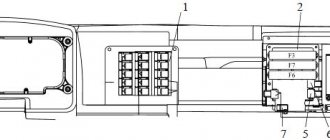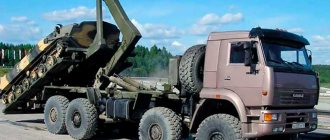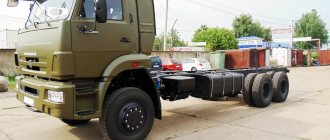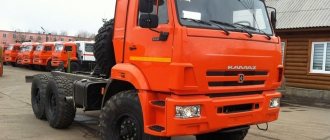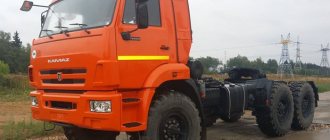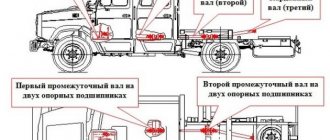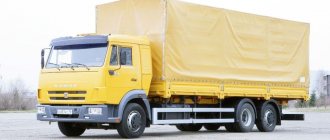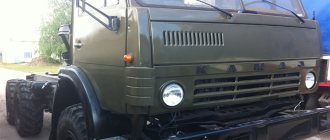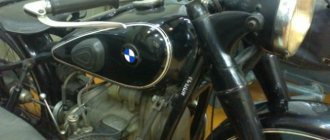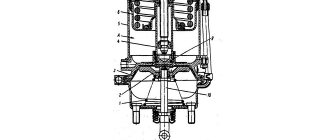History of the car
The specified truck entered mass production in 1981. It was produced in the city of Naberezhnye Chelny at the KamAZ enterprise. The peculiarity of this vehicle is precisely the fact that it was designed by specialists from the ZIL association. The advantage of the model is the presence of a hydraulic system, which is present in each of the modifications.
Owner reviews
Owners of the KamAZ-43101, which is widely used in both the civilian and military spheres, actively share feedback on their experience of using the truck. Among the main advantages of the car, car enthusiasts often note high cross-country ability and stability in difficult terrain and large differences in altitude. Truck drivers are pleased with the ability of the KamAZ-43101 to travel through difficult off-road conditions, and sometimes through swampy terrain.
In addition, car enthusiasts highlight a number of other advantages, among them: large load capacity, all-wheel drive with a 6x6 wheel arrangement, ease of repair, resistance to temperature overloads and a large number of spare parts on the market in Moscow and other cities. There are only two shortcomings identified by truck owners: high fuel consumption and an outdated cabin with low comfort. The last minus is obviously related to the year of development of KamAZ-43101. Most reviews for this truck are positive.
Operating parameters of the KamAZ truck
The operational parameters of the KamAZ-43101 vehicle distinguish it from all previous models:
| Load capacity | 6 t |
| Curb weight | 8.745 kg |
| Front axle load | 4.315 kg |
| Cart load | 4.43 kg |
| Gross vehicle weight including all additional equipment and accessories | 15.2 t |
| Maximum trailer weight on asphalt roads | 10 t |
| Maximum permissible trailer weight on all types of roads | 7 t |
| Maximum possible vehicle speed | 85 km/h |
| Possible speed as part of a road train | 80 km/h |
| The time it takes the car to accelerate to 60 km/h | 35 s |
| The angle of elevation that a cargo SUV (as part of a road train) can overcome | 31 (20) degrees |
| Vehicle coasting from 50 km/h | 600 m |
| Distance required to stop the vehicle while driving | 17.2 m |
| Fuel consumption at average speed | 30 l/100 km |
| Minimum fuel consumption | 155 g/(hp.×h) |
| The depth of a ford that a car can overcome | 0.8 m |
| Shaft rotation speed | 2600 min-1 |
| Turning radius on outer wheel | 10.5 m |
| Cabin weight | 0.533 t |
| Loading platform weight | 925 kg |
| Power unit weight | 0.72 t |
Overall dimensions of serial KAMAZ-43101 (1989 - 1995)
Transmission on a KamAZ truck
The KamAZ-43101 vehicle is equipped with a five-speed manual transmission. The dispensing unit is equipped with a two-stage gearbox. The torque is distributed in a certain ratio between the front and rear axles of the loading platform. This is achieved due to the presence of a cylindrical center differential of the planetary type.
Control and monitoring of the operating parameters of the transfer case is carried out remotely; there is an electro-pneumatic drive. Power take-off from the transfer case is up to 60 hp. With. Four cardan shafts form the driveline. The front axle is of a disk type, the rear axle is of a through type.
Front axle KamAZ 43101
Steering, winch
The KamAZ-43101 steering mechanism is formed from a screw with a ball nut and a rack-shaped piston. It is complemented by a hydraulic booster, which provides a gear ratio of 20.
The winch on the truck is equipped with a band brake. It is a drum type mechanism. The drive is carried out from the power take-off. It is possible to move the cable forward and backward, which is achieved due to the presence of a block. Its working length ranges from 83.5 m.
Winch device for KamAZ-43101 car
Device
KamAZ 43101 is equipped with independent suspension. At the front it is mounted on semi-elliptical springs with rear sliding ends and shock absorbers. At the rear there is a balancer suspension on semi-elliptical springs with sliding end parts and reaction bars. The special design allows the vehicle to ford a depth of up to 1.5 m. Rubber buffers are mounted on the lower flanges of the side members to soften the impacts of the front axle and frame.
The car is driven using a 5-speed transmission with synchronizers in all gears except first. KamAZ 43101 is also equipped with a 2-stage gearbox and a planetary locking center differential, which allows the force to be distributed between the front axle and the rear bogie in a ratio of 1 to 2. The main gear of the drive axles is double. It includes 2 bevel gears with spiral teeth and 2 spur gears with helical teeth. The gearbox is controlled remotely.
The steering mechanism is represented by a system consisting of a screw equipped with a ball nut and a piston-rack. The basic configuration includes a hydraulic booster.
The brake system is represented by several types of systems:
- service brake system with drum devices and 2-circuit pneumatic drive. Drum diameter – 400 mm, lining width – 140 mm;
- parking brake with pneumatic drive, powered by spring energy accumulators;
- spare brake system combined with a parking brake;
- auxiliary brake, represented by a motor retarder with a pneumatic drive;
- trailer brake system with combined drive.
Electrical equipment includes 2 batteries, voltage regulator and generator.
KamAZ 43101 is equipped with a 3-seater cab, which is tilted using a hydraulic lift. The cabin is equipped with an independent heater, ventilation system and good thermal and noise insulation. For the driver there is a sprung seat with settings for backrest angle and length. Optionally, the cabin is complemented by a sleeping area. KamAZ 43101 is equipped with old-style cabs.
The car body is represented by a metal platform with a wooden floor and folding sides (rear and side). The platform can be equipped with an awning and a frame. Additionally, removable benches are available to allow the carriage of up to 30 people in the bed, and extendable mesh sides for the side.
Dimensions:
- length – 7895 mm;
- width – 2500 mm;
- height – 2860 mm;
- wheelbase – 3340 (+1320) mm;
- front track – 2010 mm;
- rear track – 2010 mm;
- ground clearance - 365 mm;
- loading height – 1530 mm;
- outer turning radius – 11300 mm.
Cabin interior
The cabin turned out to be 3-seater and has thermal insulation, which, together with noise insulation, allows you to feel more comfortable. They also didn’t forget to introduce an independent hot-air heater. The cab can be tilted forward using a hydraulic lift.
The basic configuration does not have a bed, but it can be installed as a separate option. The driver's seat is sprung and can be adjusted in length, weight and backrest angle. On top of that, the manufacturer provides tropical seat configurations.
It is clear that the interior of the KamAZ-4310 is still very far from its European analogues, but at that time of production the cabin was quite cozy and made it possible not to get so tired during long work. The seats themselves are quite simple. The instrument panel looks spartan, but everything you need is located on the dashboard.
Do not forget that many copies were adopted by the army, where comfort is not so important, but preference is given to maneuverability, reliability and functionality. It is possible to lower the visor on a bright sunny day for both the driver and the passenger.
Optional equipment:
- engine pre-heater;
- self-pulling winch;
- benches for transporting people;
- seat belts;
- cabin with berth.
Winch
KamAZ is equipped with a mechanical, drum-type winch. It is equipped with a worm gearbox and a band brake mechanism. The winch itself is driven by a power take-off box through a cardan drive.
During operation, the winch cable is fed forward and passes back through a cylindrical block.
Technical indicators:
- forward traction force - 10,800 kgf;
- rear traction force - 15,400 kgf;
- working cable length - up to 83.5 m;
- load capacity - 6,000 kg.
The winch consists of:
- A worm, a pressure roller with springs, which is located in the upper part of the drum.
- A band brake, which is used to brake the shaft when the clutch is disengaged.
- A cable layer that lays the cable evenly and tightly on the drum mechanism.
Other vehicle equipment
Winch KamAZ-43101
KamAZ-43101 has disc wheels. It is possible to adjust the air pressure within 3.2 kgf/cm. It is set taking into account existing road conditions, which ensures more efficient operation of the vehicle. The truck is equipped with six wheels (plus one included for replacement).
The main braking system installed on the vehicle is of the drum type. It has a double-circuit pneumatic drive. The parking brake is combined with a spare one. It consists of trolley brakes that are powered by spring batteries. This system has a pneumatic drive.
The role of an auxiliary brake is performed by the motor retarder. The trailer is equipped with a combined type brake system drive with thermodynamic drying of compressed air.
Body and interior structure
The body and interior structure includes:
- Motor zone. It is intended for the power unit and components associated with it. It also performs the function of passive vehicle safety.
- Brake system.
- Chassis and tire pressure control system.
- A steering system that is connected to the front axle of the truck.
- Space for passengers and driver, as well as a berth.
- The clutch system that connects the engine to the transmission while the vehicle is in motion.
- A dashboard that displays the operation of all major equipment systems.
- A platform designed to accommodate cargo for transportation.
The motor part includes the following parts:
- front upper and lower cross member;
- Front type spars.
Refueling volumes
When operating a KamAZ-43101 vehicle, it is necessary to take into account the following values of its filling capacities (in liters):
- fuel tank - 125 (two pieces);
- cooling system - 36.6 (including heater);
- engine lubrication container – 33;
- power steering – 4,2;
- checkpoint – 8,5;
- transfer case and power take-off – 5,4;
- winch gearbox – 3,9;
- clutch hydraulic drive – 0.28 (filled with brake fluid).
Fuel tank KamAZ-43101
FUEL SUPPLY SYSTEM FOR KAMAZ VEHICLES ENGINES - PART 1
The fuel supply system ensures fuel purification and its uniform distribution throughout the engine cylinders in strictly dosed portions. KamAZ engines use a split-type fuel supply system, consisting of a high-pressure fuel pump, injectors, coarse and fine filters, a low-pressure fuel booster pump, low- and high-pressure fuel lines, fuel tanks, a solenoid valve and flare spark plugs for an electric torch starting device.
A schematic diagram of the power system is shown in Fig. 35. Fuel from tank 1 is sucked through the coarse filter 2 by the fuel priming pump and through the fine filter 17 through low pressure fuel lines 3, 9, 15, 21 and supplied to the high pressure fuel pump; according to the operating order of the engine cylinders, the pump distributes fuel through high-pressure pipelines 6 to injectors 5. The injectors spray and inject fuel into the combustion chambers. Excess fuel, and along with it the air that has entered the system, is discharged into the fuel tank through the bypass valve of the high-pressure fuel pump and the fine filter nozzle valve via fuel drain lines 16 and 18. The fuel that has leaked through the gap between the nozzle body and the needle is drained into the tank through fuel drain lines 4, 14, 20.
Rice. 35. Engine fuel supply diagram: 1 - fuel tank; 2 — fuel coarse filter; 3 — fuel pipe supplying the low pressure pump; 4 — fuel drainage pipe of the left head injectors; 5 - nozzle; 6 - high pressure fuel pipe; 7 — low pressure fuel priming pump; 8 — manual fuel priming pump; 9 — fuel outlet pipe of the low pressure pump; 10 — high pressure fuel pump; 11 — electromagnetic valve; 12-fuel pipe to the solenoid valve; 13 — torch candle; 14 — fuel drain pipe for right-hand injectors; 15 — fuel injection pipe; 16 — fuel outlet pipe of the injection pump; 17 — fine fuel filter; 18 — fuel fine filter tube; 19 — tee for fastening fuel pipes; 20 — fuel drain pipe; 21 — fuel line to the coarse filter; 22 — receiving pipe with filter
The coarse filter (sump) (Fig. 36) pre-cleanses the fuel entering the low-pressure fuel priming pump. It is installed on the suction line of the power system on the left side of the vehicle on the frame.
Glass 2 is connected to housing 10 with four bolts 7 and sealed with ring 9. A drain plug 1 is screwed into the bottom of the cap boss. The fuel coming from the fuel tank through the supply fitting flows into the glasses. Large particles and water collect at the bottom of the glass. From the upper part, through filter mesh 4, fuel is supplied to the fuel priming pump through the outlet fitting and fuel lines.
A fine filter (Fig. 37), which finally cleans the fuel before entering the high-pressure fuel pump, is installed at the highest point of the power system to collect and remove into the tank the air that has entered the power system along with part of the fuel through a nozzle valve installed in the housing 1. The beginning of the shift of valve-nozzle 4 (Fig. 38) occurs at a pressure in the cavity of 24.5... 44.1 kPa (0.25... 0.45 kgf/cm2), and the beginning of fuel bypass from cavity A to cavity B - at a pressure in cavity A of 196.2... 235.3 kPa (2.0... 2.4 kgf/cm2). The valve is adjusted by selecting adjusting washers 1 inside the valve plug.
Fuel lines are divided into fuel lines of low pressure 392... 1961 kPa (4... 20 kgf/cm2) and high pressure of more than 19614 kPa (200 kgf/cm2). High-pressure fuel lines are made of steel tubes, the ends of which are made cone-shaped, pressed with union nuts through washers to the conical sockets of the fuel pump and injector fittings. To avoid damage from vibration, the fuel lines are secured with brackets and brackets.
The high-pressure fuel pump is designed to supply strictly dosed portions of fuel under high pressure to the engine cylinders at certain times. Eight sections are installed in housing 1 (Fig. 39), each consisting of housing 17, sleeve 16 of plunger 11, rotary sleeve 10, discharge valve 19, pressed through sealing gasket 18 to the plunger sleeve
fitting 20. The plunger performs a reciprocating movement under the action of the shaft cam 44 and spring 8. The pusher is secured from rotation in the housing by a block 6. The cam shaft rotates in roller bearings 42 installed in the covers and attached to the pump body. The axial clearance of the cam shaft is adjusted by shims 48. The clearance should be no more than 0.1 mm.
To increase the fuel supply, the plunger 11 is rotated by a sleeve 10 connected through the axis of the driver to the pump rack 15. The rack moves in guide bushings 57. Its protruding end is closed with a plug 54. On the opposite side of the pump there is a screw that regulates the fuel supply to all sections of the pump. This screw is capped and sealed.
Fuel is supplied to the pump through a special fitting, to which a low pressure pipe is bolted. Then, through the channels in the body, it flows to the inlet holes of the 16 plunger bushings.
Rice. 40. Speed controller: 1 - rear cover; 2 - nut; 3 — washer; 4 - bearing; 5 - adjusting gasket; 6-intermediate gear; 7 — gasket for the rear cover of the regulator; 8 — retaining ring; 9 — load holder; 10 — load axis; 11 - thrust bearing; 12-clutch; 13-cargo; 14-finger; 15-corrector; 16-return spring of the stop lever; 17-bolt; 18-bushing; 19-ring; 20-lever of the regulator spring; 21-gear drive; 22-cracker of the drive gear; 23-drive gear flange; 24 — fuel supply adjusting bolt; 25- starting spring lever; 26 - regulator spring: 27 - rack; 28 — starting spring; 29 — pin; 30 — rack lever; 31 — regulator lever; 32 - load clutch lever; 33 — axis of the regulator levers; 34 - bolt for securing the top cover
Characteristics of fuel equipment
content .. 11 12 17 ..
Description of the military modification
In the early 90s, based on this KamAZ model, they began to produce the Typhoon-1 military vehicle. At that time, the truck was one of the best and was actively used. This modification is equipped with a spacious cabin, which is designed for transporting personnel. The car has powerful armored front plates that provide it with additional protection.
Typhoon-1
KamAZ-43101 is used in the military industry in another form. The car may have a metal platform, which is equipped with folding side walls. The body of such a vehicle is equipped with a durable frame and awning. The flooring in it is made of wood.
In this model, the cabin is tilting with a hydraulic lift. The advantage of the truck is the presence of heat and sound insulation. Upon request, the cabin can have a berth.
What they write on the forums: reviews of KamAZ-43101 owners and drivers
Efim Evstigneev, 55 years old, Krasnoyarsk Territory:
I have owned a KamAZ-43101 timber truck for more than ten years. When purchasing, the main criterion was the vehicle's cross-country ability: there are no roads where I work. I was not mistaken in my choice - this is truly an all-terrain vehicle: it goes through mud and will get out of any swamp. The engine, gearbox and clutch are very easy to maintain and repair; it is important not to forget to maintain and lubricate them on time. I won’t talk about comfort in the cabin: what’s missing is missing, the green color makes me happy – dirt isn’t so visible.
Main modifications of the KamAZ-43101 vehicle
KamAZ-43101 has many modifications that differ in some technical characteristics and have different functional purposes:
- 4310. It is the basic version, the body contains seats for 30 people, the platform is shortened and equipped with an awning;
- 43101 experienced. This model is considered more of a transport model; there are folding sides on three sides;
- 43101. Truck with a power of 220 hp. pp., with a load capacity of 6 tons, was produced until 2000 inclusive;
- 431010. A specially created modification that was intended for participation in sports competitions;
- 43102. This car is additionally equipped with a berth located in the cabin;
- 43103. The model is similar in its characteristics to the previous modification. Equipped with a sleeping place in the cabin;
- 43105. It is considered a civilian vehicle. Its design lacks a winch and the ability to adjust tire pressure;
- 43106. One of the civilian modifications. The car is equipped with a KamAZ-740.10-20 engine;
- 43114. One of the army options. This model has a turbocharged diesel engine with a power of 260 hp. With.;
- 43115. This modification belongs to the category of civil transport vehicles;
- 43118. Transport model with an enlarged cargo platform;
- 4410. A truck tractor designed for towing semi-trailers weighing up to 15 tons.
Related video: KamAZ 43101
Publications on the topic
Design features of the KamAZ 4310 truck
Description of the device and technical characteristics of Ural-43206
How is transport tax calculated on a car?
Engine
KamAZ 43101 was equipped with a 4-stroke overhead valve KamAZ 740.10-20 diesel engine with liquid cooling, V-shaped cylinder arrangement, camber angle of 90 degrees and turbocharging. The engine differed from the base KamAZ 740.10 unit by greater power and thrust. The power plant coped well with critical loads and harsh operating conditions.
Characteristics of the KamAZ 740.10-20 engine:
- working volume – 10.85 l;
- rated power – 164 (220) kW (hp);
- maximum torque – 667 Nm;
- compression ratio – 16;
- number of cylinders – 8;
- cylinder diameter – 120 mm.
The car had 2 fuel tanks with a capacity of 170 l and 125 l.
